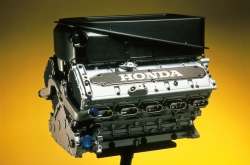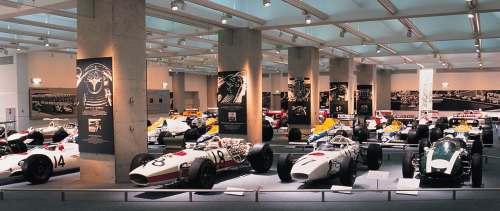|
|
|

| The Honda Racing Pedigree. | |
Ever since Soichiro Honda raced cars in the 1930s, he had been looking for an opportunity to revive his ambitions in motorsport. Visiting the Isle of Man in June 1954, to see for himself what the motorcycling world regarded as the pinnacle of accomplishment, he asserted: “Since I was a child, I have dreamed of building an automobile with my own hands and having it dominate world motor racing competition.” He took part in motorsport not just through enthusiasm or even to promote sales. He believed racing exercised engineers’ minds and raised morale at Honda factories. By 1959 Honda began to prevail in its new activities and the company’s determination gained respect long before it won a TT outright, but in 1961 Honda took the first five places in both the 250cc and 125cc races.
| |
| Honda in Formula One. | |
|
Honda entered its first Grand Prix, alongside Ferrari, Mercedes-Benz, Lotus, Alfa Romeo, and Maserati, with a complete car in 1964, just one year after mass car production had started. In October 1965, after just 10 races, Honda won its first GP in Mexico with Richie Ginther at the wheel of the RA272. By 1968, Honda had recorded two Grand Prix victories, and had also starred in the F2 championship in which Jack Brabham had claimed 11 consecutive victories in 1966. But despite being unable to fulfil Soichiro Honda’s dream of winning the F1 world championship, the company announced a ’temporary withdrawal’ from the sport. Honda’s return to Formula 1 in the 1980s followed a run of success in Formula 2 that began in 1980. In only its second season, the Ralt-Honda won the Formula 2 championship in Europe and took Satoru Nakajima to victory in the Japanese championship. The second generation of F1 began with Stefan Johansson in the Spirit-Honda at the 1983 British Grand Prix, but engine supply soon switched to the Williams team. In the course of the next nine seasons, Honda was to record a further 69 Formula One victories. Two successes were gained with Honda engines in Lotus cars, and Honda engines in Williams cars won 23 Grands Prix, a Drivers’ World Championship and two Constructors’ World Championships between 1984 and 1987. From 1988 to 1992 Honda supplied engines to McLaren, winning 44 Grands Prix and the Constructors’ and Drivers’ titles four years in succession, a run of success unprecedented in modern motor racing. To add to the titles, the McLaren-Honda MP4/4 dominated the 1988 season winning 15 out of 16 races, a feat unlikely ever to be repeated. The decision to withdraw from Grand Prix racing at the end of 1992 was taken in light of the company having achieved all the targets that had been set for the programme, but within eight years, the challenge of top level motor sport proved too great for Honda to resist. Honda’s third generation has brought new challenges and new relationships with new teams. No longer just an engine supplier, Honda engineers also began working on chassis technology with British American Racing as Honda returned to F1 racing in 2000. The objectives of Honda’s new venture into F1 were clearly set out to develop the skills of young engineers, to develop new technologies and once again to establish Honda as the dominant force in Grand Prix racing. For 2001, Honda joins forces with Jordan Grand Prix for a two-team assault on the World Championship.
| |
 The Honda RA001E V10 Formula One engine | |
| The Honda Collection Hall. | |
|
Throughout the history of Honda’s Formula One competition the principles of the racing tradition set out by Soichiro Honda have been adhered to. The ideals of innovation, engineering excellence and the passion for racing have been handed down through the generations of Honda technicians, but the Honda company wanted a more physical and tangiable memorial. To this end a purpose-designed Honda museum was built at Motegi, Japan in 1998.
The museum’s 450 exhibits include not only many of Honda’s oldest and most successful race cars and bikes. They also feature a fascinating selection of weird and wonderful machines, part of Honda’s huge and varied production output over the years. Race car highlights include the McLaren Honda MP4/4, the all-conquering 1988 F1 car that claimed a remarkable 15 wins out of 16 races, and examples of every Honda machine from the first era of F1 competition such as the famous John Surtees RA300 that won at Monza in 1967.  The Honda Collection Hall
|
| Honda's Formula One success. | |||
| GP Starts | 203 |
||
| Wins | 71 |
||
| Pole Positions | 74 |
||
| First Win | 1965 Honda RA272, Richie Ginther, Mexico |
||
| First Constructor's Title | 1986 Williams-Honda, Piquet / Mansell |
||
| First Drivers's Title | 1987 Williams-Honda, Nelson Piquet |
||
| 6 Consecutive Constructor's Title |
1986 Williams-Honda 1987 Williams-Honda 1988 McLaren-Honda 1989 McLaren-Honda 1990 McLaren-Honda 1991 McLaren-Honda |
||
| 5 Consecutive Drivers's Title |
1987 Williams-Honda, Nelson Piquet 1988 McLaren-Honda, Ayrton Senna 1989 McLaren-Honda, Alain Prost 1990 McLaren-Honda, Ayrton Senna 1991 McLaren-Honda, Ayrton Senna |
||
| Driver Wins |
|
||
| Team Wins |
|
||
| Honda's success in 2000. | |
| Formula One | 5th in Constructors Championship |
| CART | Gil de Ferran - Champion, 5th Driver's Championship in a row for Honda. |
| All Japan GT | Ryo Michigami - Champion |
| European Touring Cars | Peter Kox, 2nd in Championship |
| World Superbikes | Colin Edwards - Champion |
| 500cc Motorcycle Grand Prix | Valentino Rossi - 2nd place |
| 250cc Motorcycle Grand Prix | Daijiro Katoh - 3rd place |
| Suzuka 8-hours | Daijiro Katoh & Tohru Ukawa - Champions |
| Isle of Man TT | Honda won 5 TT Championships, with the legendary Joey Dunlop winning 3 TT Championships. Joey Dunlop was tragically killed at a road race in Estonia, less than a month after winning his last TT |
| World Motocross 250cc | Frederic Bolley - Champion |
| World Trials | Dougie Lampkin - Champion |
